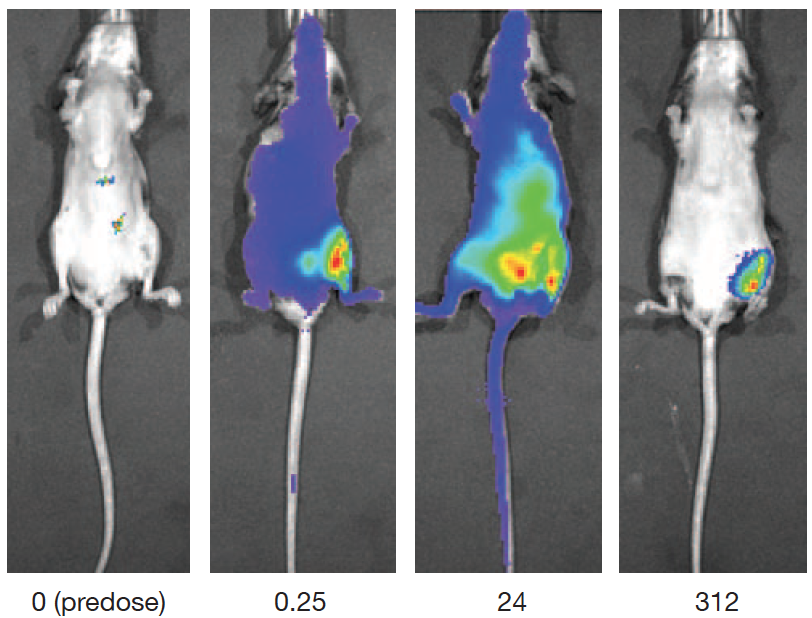Super Fluor® 488,555, 647, 680, 750 NHS ester
SE =NHS = succinimidyl ester
Super Fluor®为北京富百科生物技术有限公司注册商标,未经授权严禁使用!
1.Introduction
Super Fluor® dyes are the ideal substitute for Alexa Fluor dyes. Super Fluor® dyes are a series of superior fluorescent labeling dyes that span the full visible spectrum. These dyes have better labeling performances than the classic fluorescent labeling dyes such as Cy 3, Cy5, FITC and Texas Red. Superfluor dyes and their conjugates have the following advantages:
· Absorption maxima compatible with all the common light sources of fluorescent instruments.
· Superfluor conjugates exhibit more intense fluorescence than other spectrally similar conjugates of classic fluorescent dyes such as FITC, TAMRA and ROX under similar excitations.
· Superfluor dyes are more photostable than the classic fluorescent dyes such as FITC, Cy3 and Cy5.
· Superfluor dyes have good water solubility for ease of conjugation and the resultant conjugates are resistant to precipitation and aggregation
· Superfluor dyes and their conjugates are available in several distinct fluorescent colors.
· Superfluor dyes are highly fluorescent over a broad pH range with little pH sensitivity.
· Superfluor dyes are available in a variety of reactive forms.
Superfluor® 750 Dyes, Superior Upgrades for Cy7 Dye Derivatives
Spectrally similar to Cy7 dye, Superfluor 750 dye is the longest-wavelength Superfluor dye currently available. Its fluorescence emission maximum at 778 nm is well separated from commonly used far-red fluorophores such as Superfluor 647, Superfluor 680 or allophycocyanin (APC), facilitating multicolor analysis. With a peak excitation at ~753 nm, conjugates of Superfluor 750 dyes are well excited by a xenon-arc lamp or dye-pumped lasers operating in the 720–750 nm range.
Superfluor® 750 Labeling Dyes
Cat# | Name | Size | Price | Ex (nm) | Em (nm) | Soluble in |
1161 | Superfluor™ 750 acid | 5 mg | $95 | 750 nm | 775 nm | Water |
1162 | Superfluor™ 750 acid, SE* | 1 mg | $95 | 750 nm | 775 nm | Water |
1456 | Superfluor™ 750 C5 maleimide | 1 mg | $195 | 750 nm | 775 nm | Water |
1556 | Superfluor™ 750 hydrazide | 1 mg | $195 | 750 nm | 775 nm | Water |
*SE = succinimidyl ester.
NHS ester labeling of amino biomolecules
Super Fluor 488,555, 647, 680, 750
488 | 555 | 647 | 680 | 750 | |
molecular weight | ~900 | ~1250 | ~1300 | ~1150 | ~1300 |
λmax(nm) Ex | 494 | 555 | 647 | 680 | 750 |
Molar Absorption Coefficient(M-1cm-1) | 71 000 | 150 000 | 239 000 | 184000 | 240 000 |
λmax(nm) Em | 524 | 565 | 665 | 702 | 775 |
A280nm /Amax | 11% | 8% | 3% | 5% | 4% |
Succinimidyl esters are proven to be the best reagents for amine modifications because the amide bonds that are formed are essentially identical to, and as stable as the natural peptide bonds. These reagents are generally stable and show good reactivity and selectivity with aliphatic amines. There are few factors that need be considered when SE compounds are used for conjugation reaction:
1). Solvents: Dissolve NHS ester in 1/10 reaction anhydrous volume of DMF or DMSO.
2). Reaction pH: The labeling reactions of amines with succinimidyl esters are strongly pH dependent. Amine-reactive reagents react with non-protonated aliphatic amine groups, including the terminal amines of proteins and the e-amino groups of lysines. Thus amine acylation reactions are usually carried out above pH 7.5. Protein modifications by succinimidyl esters can typically be done at pH 7.5-8.5, whereas isothiocyanates may require a pH 9.0-10.0 for optimal conjugations.
3). Reaction Buffers: Buffers that contain free amines such as Tris and glycine and thiol compounds must be avoided when using an amine-reactive reagent. Ammonium salts (such as ammonium sulfate and ammonium acetate) that are widely used for protein precipitation must also be removed (such as viadinlysis) before performing dye conjugations.
4). Reaction Temperature: Most conjugations are done at room temperature. However, either elevated or reduced temperature may be required for a particular labeling reaction.
5) Use 10:1 molar ratio Dye NHS/ protein to perform the labeling. Calculate required amount of NHS ester and the protein.
6) Add NHS ester solution to the solution of biomolecule, and vortex well. Keep on ice overnight, or at room temperature during at least 4 hours.
7) Purify the conjugation. The dye-protein conjugate purification by using a Sephadex G-25 column. Add PBS (pH 7.2-7.4) to the desired sample to complete the column purification. Combine the fractions that contain the desired dye-protein conjugate.
8) Determine the optimal dye/protein ratio (optional):Each protein requires distinct dye/protein ratio, which also depends on the properties of dyes. Over labeling of a protein could detrimentally affects its binding affinity while the protein conjugates of low dye/protein ratio gives reduced sensitivity.
Safety warnings and precautions
NOTE: The qualified persons should always wear lab coats, gloves and goggles when working with our products although they are low-risk chemicals for R&D only.
| Name | Super Fluor 750 SE (~Alexa Fluor 750 SE) | ||
|---|---|---|---|
| CAT# | 1037-1mg | CAS# | N/A |
| Storage# | −20°C干燥避光 | Shelf Life# | 12 months |
| Ex(nm)# | 750 | Em(nm)# | 775 |
| MW# | N/A | Solvent# | Water or DMSO |
| Name | Super Fluor 750 SE (~Alexa Fluor 750 SE) |
|---|---|
| CAT# | 1037-1mg |
| CAS# | N/A |
| Storage# | −20°C干燥避光 |
| Shelf Life# | 12 months |
| Ex(nm)# | 750 |
| Em(nm)# | 775 |
| MW# | N/A |
| Solvent# | Water or DMSO |


 Specification
Specification Support
Support



